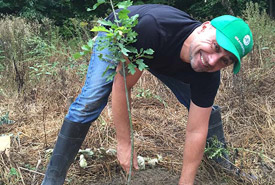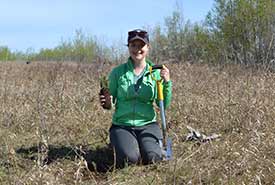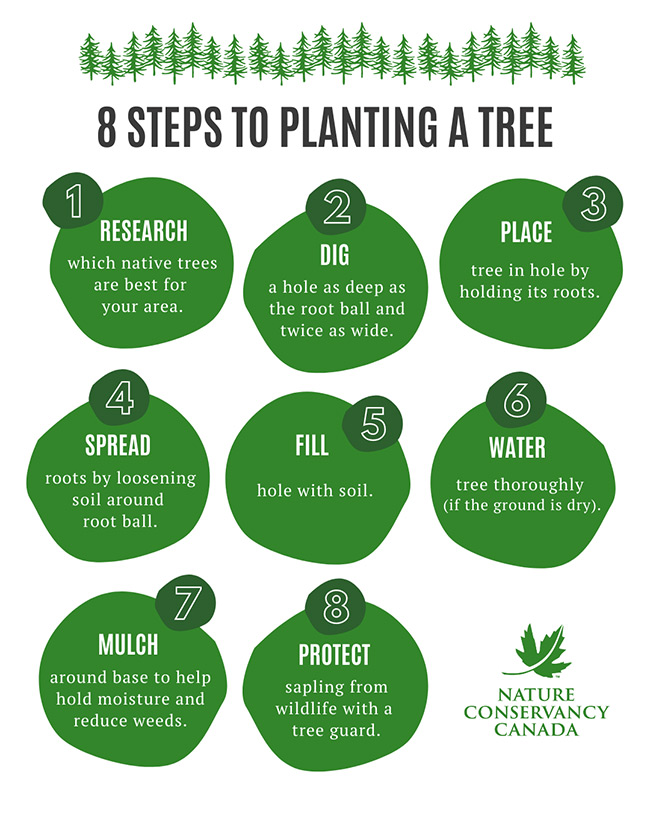Planting trees for a greener planet

Conservation Volunteer planting a tree in Happy Valley Forest, ON (Photo by Mimi Chan)
I recall in the 1990s when a news crew came to my school to film us — a bunch of 10-year-olds — planting trees in the perimeter of our playground for Earth Day. It was a novel experience, as a new immigrant to Canada from a concrete jungle called Hong Kong. I thought, “Canada has all this land where you can just put a tree in the ground!”
Fast forward 10 years and I found myself in southern Australia with a group of international student volunteers. We toured the eastern coast of the country, helping local conservation authorities with tree planting, riparian restoration and invasive plant removal. I think about those saplings from time to time, how they’ve grown, and hope that some were spared from the Australian bush fires.

Tree planting at Meeting Lake 03 property in Saskatchewan (Photo by NCC)
Tree planting has always been one of the flagship activities symbolic of helping the environment. The United Nations Environment Programme promotes The Trillion Tree Campaign, with the intention of moving people of all ages to action. The Government of Canada committed to planting two billion trees by 2030 as a part of our natural climate change solution.
Planting a tree is not just for increasing green space. Did you know that one large tree can provide a day’s oxygen for up to four people?
A tree has many functions, including:
- providing habitat, food and shelter for wildlife
- purifying air and water
- capturing and storing carbon
- controlling floods
- providing shade
- providing recreation
So, if you’re ready to roll up your sleeves and plant some trees, but aren’t sure how, read below for steps and tips.
What tree to plant and where
There are 137 species of native trees in Canada, according to the Database for Vascular Plants of Canada. Each forest region across the country has different species that are found there.
To begin, find out what kind of soil is on your ground. Visit a local native plant nursery or use iNaturalist and learn about the suitable species for your area. Also research what trees are available for purchase.
The infographic below shows the basic steps of planting a tree:

Best time to plant a tree
Spring and fall are the best seasons for planting new trees in countries with colder climates like Canada. So, get your shovels ready in spring when the frost clears, or in fall after the leaves fall but before the ground freezes. Planting trees in summer can put stress on young trees if it is too hot or dry.
Plant a tree for any occasion
Looking for a reason to plant trees? Why not celebrate birthdays, milestones, achievements and more by planting a tree? Here are some alternative ways to celebrate beyond the traditional balloon.
No land? No problem
If you don’t have the space to plant a tree, consider supporting conservation organizations like the Nature Conservancy of Canada in conserving important natural areas and biological diversity across all regions of Canada.
Local organizations, such as LEAF (Local Enhancement & Appreciation of Forests), offer planting and maintenance programs to help interested homeowners, schools and businesses contribute to enhancing urban forests. You can choose an in-person consultation with an arborist, followed by the delivery of a native tree and then the actual planting. Or choose to plant it yourself following a virtual consultation.
Wherever you are, planting trees is one of the most impactful ways to see results on the ground — literally. If you’ve planted a tree in the past, we’d love to hear how it has grown, the wildlife it has attracted and how it benefited the area.
To learn more about the species in your area, visit iNaturalist.


